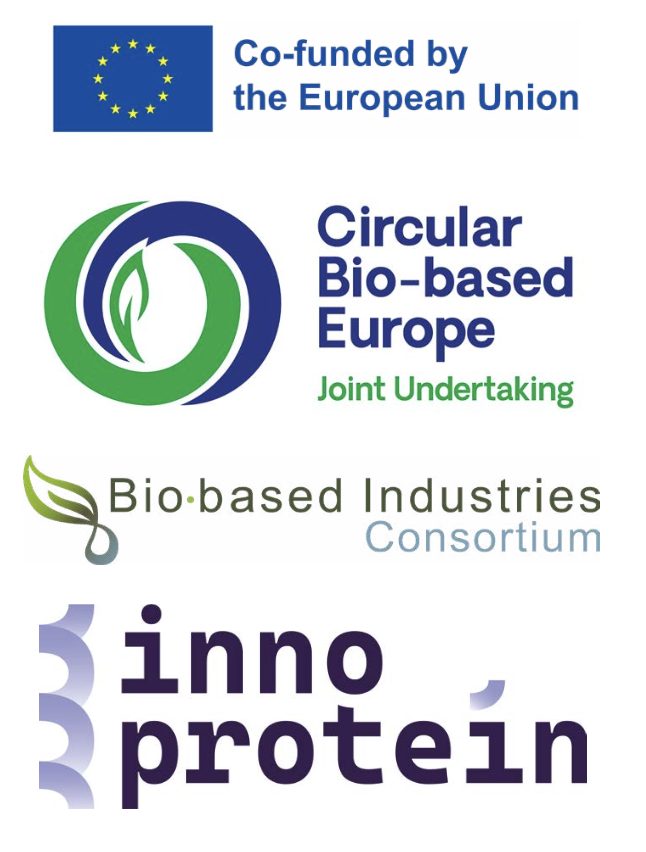InnoProtein consortium, explain why sustainable protein production is urgently needed and how, with its circular, zero-waste approach, InnoProtein supports this goal
By 2050, population growth will play a major role in the state of the environmental, social and economic system. (1) Traditional protein products, with their vast amounts of animal derivates, are being presented as sustainably obsolete due to the high consumption of natural resources employed for their production. (2)
Current protein production has a high environmental impact, and a general transition towards greener and sustainable consumption is required. Agriculture is responsible for 70-85% of the world’s water footprint and 30% of global GHG emissions. Meat production is the most impactful activity in food production.
Furthermore, the European livestock sector depends heavily on imported soybeans as the major protein source, with a high environmental impact (4.6–7.8kg CO2 eq/kg protein). (3) It is estimated that there is a 25–40% reduction in GHG emissions in the EU, reducing the intake of meat, dairy products, and eggs. (4) Moreover, food demand is expected to grow by 70% by 2050, which will increase associated impacts as well.
To address these challenges, the EU-funded InnoProtein project aims to tackle the utilization of sustainable protein sources that are currently underexploited through a circular, non-waste approach that will focus on environmental, technological, economic, and social viability. The project will study novel protein sources for human and animal consumption, such as single-cell proteins (SCPs), which include microalgae, bacteria, fungi, and insects. Additionally, it will also tackle the conversion of agrifood waste and residual biomass from the protein extraction processes into raw materials for biodegradable cutlery, biofuels and even plant stimulants, closing the cycle.
InnoProtein and the circular 0-waste approach
The solution offered by InnoProtein is based on an innovative approach to sustainable protein production, focusing on a circular, zero-waste model. This approach responds to the growing need to find viable and sustainable alternatives to conventional protein sources, such as meat and dairy products, whose production can be resource-intensive and generate a significant amount of waste.
At the heart of InnoProtein’s strategy is the use of technologies and processes that minimise or eliminate waste generation during protein production. This involves process design that maximises resource efficiency and minimises unwanted by-products.
For example, when using protein sources such as single-cell proteins (SCPs) and insects, the aim is not only to maximise the amount of protein produced but also to find innovative ways to use the by-products and waste generated in the process. These by-products may include unused biomass, by-products from protein extraction, or waste materials from insect production.
However, this approach faces several challenges. One of the main challenges is the identification and selection of suitable feedstocks that are sustainable, abundant and economically viable. Alternative protein sources, such as SCPs and insects, may require specific cultivation or processing conditions that can increase production costs.
In addition, the availability and accessibility of these raw materials may vary according to geographical region and climatic conditions, which may affect the economic viability of their large-scale use. It is, therefore, crucial to develop efficient cultivation, collection and processing methods that maximise feedstock yields and minimise costs and environmental impacts.
The residual biomass generated during the protein production process can be utilised in various ways using the InnoProtein approach. One option is to use it as feedstock for the production of other value-added products such as bioplastics, biofuels or chemicals. This requires appropriate processing and conversion techniques to transform the biomass into usable forms for these applications. Another possibility is to use the waste biomass as feed for other biological processes, such as biogas production or fermentation for the production of chemicals or bio- products. This may require optimisation of cultivation conditions and processes to ensure efficiency in the conversion of residual biomass into valuable products. Ultimately, using waste biomass effectively can help to close the resource cycle and reduce reliance on virgin feedstocks, thus contributing to a zero-waste approach to sustainable protein production.
How do we assess the impact? The LCA and LCCA models
Assessing the impact of novel protein sources involves a comprehensive evaluation across various dimensions, allowing for a determination of their sustainability and ensuring a holistic understanding of their implications. Firstly, conducting a life cycle assessment is essential, providing a detailed analysis of environmental category impacts from raw material extraction and production to disposal. This includes examining factors such as land use, water consumption, energy use, greenhouse gas emissions, and waste generation at each stage of the production process. Furthermore, the LCA and LCCA results permit the evaluation of the nutritional profile to be crucial, assessing protein quality, amino acid composition, bioavailability, and the presence of essential nutrients to determine their dietary value. Health effects must also be carefully considered, including investigating potential allergies, intolerances, or adverse effects associated with consumption and ensuring consumer safety.
Moreover, economic factors play a significant role in evaluating the feasibility and market viability of scaling up solutions, considering production costs, market demand, pricing dynamics, and potential economic benefits. Social factors are equally important, addressing the impact on food security, livelihoods, cultural practices, and community wellbeing. Engaging diverse stakeholders, including producers, consumers, policymakers, and advocacy groups, fosters collaborative decision-making and ensures inclusivity. In addition to this, a regulatory compliance review is important to ensure that these novel protein sources comply with relevant regulations and standards governing food safety, labelling, and marketing. Address any legal or regulatory barriers that may impede their commercialization and adoption – lastly, conduct a comparative analysis of the environmental, nutritional, economic, and social impacts of these novel protein sources with conventional protein sources to understand their relative advantages and disadvantages, informing strategic choices. By thoroughly considering these dimensions, stakeholders can gain valuable insights into the overall impact of novel protein sources, guiding informed decisions regarding their adoption and promoting their sustainable adoption in the food industry.
Future of sustainable protein production and consumption
In conclusion, the imperative for sustainable protein sources in light of escalating environmental challenges and population growth is undeniable. InnoProtein’s circular, zero-waste approach offers a promising solution, leveraging innovative technologies to mitigate waste and maximize resource efficiency. However, challenges persist, particularly in sourcing sustainable feedstocks and ensuring economic viability. Assessing the impact through comprehensive models like LCA and LCCA is essential, considering environmental, nutritional, economic, and social dimensions.
By embracing these approaches, InnoProtein is paving the way for more sustainable protein production and consumption in the future.
References
- Albaladejo Román A. EU protein strategy. European Parliamentary Research Service. 2023; PE 751.426: 1-8
- La Barbera F, Amato M, Verneau F. Beyond Meat: Alternative Sources of Proteins to Feed the World. Nutrientes. 2023;15: 2899.
- Jan Erik Lindberg, et al. (2016). Nordic Alternative Protein Potentials Mapping of Regional Bioeconomy Opportunities.
- Food choices, health and environment: Effects of cutting Europe’s meat and dairy intake – ScienceDirect


This work is licensed under Creative Commons Attribution-NonCommercial-NoDerivatives 4.0 International.


